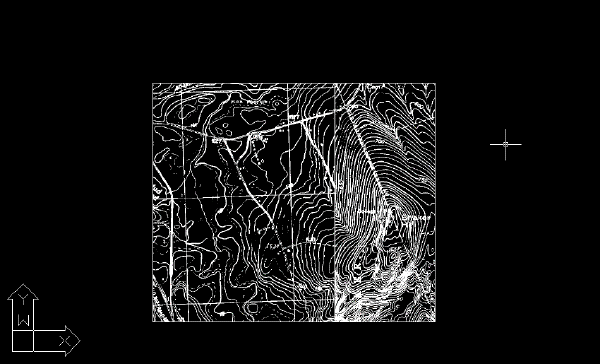In this exercise you convert color images to bitonal (black and white) images.
You convert a color image of a USGS quad sheet to a bitonal image, preparing to trace the contours with AutoCAD Raster Design toolset Vectorization Tools.
Related Exercises
Before doing this exercise, ensure that AutoCAD Raster Design toolset options are set as described in the exercise Exercise A1: Setting AutoCAD Raster Design Toolset Options.
Exercise
- In the
..\Program Files\Autodesk\ApplicationPlugins\RasterDesign2024.Bundle\Contents\Tutorials\Tutorial5 folder, open the drawing file
Map_12.dwg.
Convert the image to bitonal
- Isolate the
TU_image_usgs layer. To do this, on the ribbon, click
Home tab >
Layers panel >
Layer Properties
 . Then select the
TU_image_usgs layer in the
Layer Properties Manager, right-click and click
Select All But Current, then freeze all the selected layers.
. Then select the
TU_image_usgs layer in the
Layer Properties Manager, right-click and click
Select All But Current, then freeze all the selected layers.
- On the ribbon, click
Raster Tools tab
 Edit panel
Edit panel  Process Image drop-down menu
Process Image drop-down menu  Histogram
Histogram
 . Press
Enter for entire image. The
Histogram dialog box is displayed.
. Press
Enter for entire image. The
Histogram dialog box is displayed.
- Click the
Threshold tab.
Use the Threshold slider to determine which pixels will be black and which will be white after you convert the image.
- Move the slider as close as you can to 171, observing the effect on the image in the preview window.
This exercise uses one image. However, if you select multiple images, you can select the image name below the preview to observe the effect of the threshold value on that image. The selected images convert to black and white when you click Apply and Close.
- Click
Apply and Close to convert the image.
Save the image
- On the ribbon, click
Raster Tools tab
 Insert & Write panel
Insert & Write panel  Save As
Save As
 .
.
- In the Save As dialog box, enter
usgs.cal for the filename, select
CALS Type 1 for the file type, and click
Save.
Invert the image
- On the ribbon, click
Raster Tools tab
 Edit panel
Edit panel  Cleanup drop-down menu
Cleanup drop-down menu  Invert
Invert
 .
.

After you convert an image (and invert it, if necessary), you typically use the editing filters, such as Despeckle and the bitonal filters, to eliminate raster data that could interfere with tracing the contours.
- Close the drawing without saving changes.